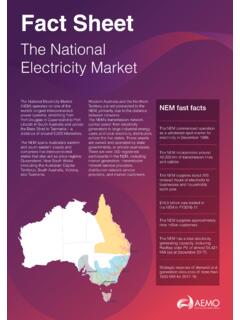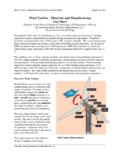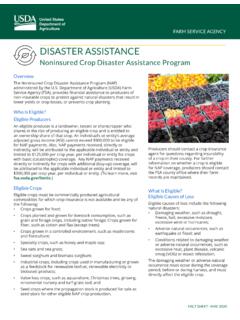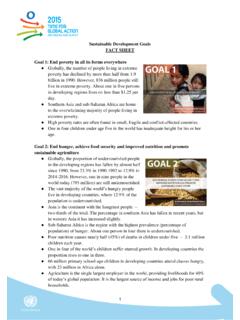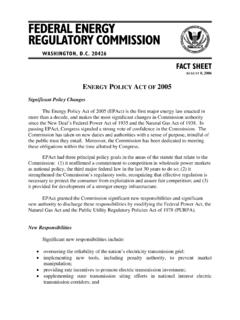Transcription of Universities Funding in South Africa; A Fact Sheet
1 1 | P a g e Universities Funding in South Africa; A fact Sheet 1. University education as a generator of both public and private goods Universities South Africa (USAf) is of the view that Universities produce public goods to the extent that university education generates new knowledge, produces research that leads to new commercial, technological, social, political and other innovations beneficial for national development. Inversely, university graduates who land better-paying jobs as a result of skills sets they bring to the labour market, reap private goods from university education. Therefore, if higher education produces both collective (public) goods ( value to the country) and private goods (value to individuals), it is logical to expect that the Funding required for higher education will derive partly from the public fiscus and partly from private investment in the form of student fees or some other mechanism that may be agreed upon over time.
2 USAf agrees with the principle of a cost-sharing model to cater for the cost of the public goods of higher education on the one hand, and that of the private goods on the other. The main Funding sources of higher education therefore, are the fiscus-based state subsidy system and the private contribution (in the form of tuition fees and/or other sources of Funding ). As such a fee-free higher education system is not supported by USAf unless there is clarity on how the full higher education budget will be constructed to maintain current levels and quality of service delivery. The tuition fee and/or other sources of Funding should be at a level that allows students and their families to see sufficient value in the investment. In many countries families assess the value of a degree by comparing the cost thereof to employability of the graduate. USAf takes the view that the level of public investment in higher education must be internationally benchmarked and matched to the value of the public good.
3 If this is not done effectively, the tuition fee portion would be so large as to systematically exclude students from poor and middle class families. 2. The University sector is underfunded Government subsidies have been declining in real terms Taking into account the importance of the large national, public good projects of the higher education system, Universities have to be adequately funded. However, in reality, the opposite is true. Several studies have shown that in comparison with other societies, this underfunding is considerable. The primary sources of Funding are the Department of Higher Education and Training (DHET) block grant based on the system of full-time student equivalents (FTEs) and student fees. For most Universities , 2 | P a g e state support on average accounts for more than two thirds of their unrestricted revenue. The student fee component in university budgets is typically in the region of 30-40%, an amount approaching R30 billion per annum if the cost of accommodation of students in residences is included.
4 The historic increases in tuition fees beyond CPI are a direct result of the fact that the subsidy allocation to Universities per full time equivalent student has been in decline and the fact that the higher education price index (HEPI) is approximately 2% higher than CPI. USAf generates HEPI, a measure of the inflation rate for higher education, by taking into account the typical spending patterns of Universities . For the period 2010/11 2012/13 this higher education price index was above CPI, and the index for 2013/14 - 2015/6 is currently in development. The methodology used to determine HEPI is explained in the Executive Summary - Research and Development of HEPI for South Africa herewith appended. Amongst the key drivers of HEPI are academic salary increases, utility costs (especially electricity), foreign exchange based expenses (book and scientific journal costs, computer hardware, software, research equipment, experimental consumables, etc.)
5 And security and cleaning contracts. These have all grown at rates higher than CPI on an annual basis. Table 1 below provides an analysis of the government Funding for higher education through the block grant system, which is at the core of the Funding levels for teaching (and research.) TABLE 1. SUBSIDY LEVELS OVER THE PERIOD 2012/2013 2014/2015. 2012/2013 2013/2014 2014/2015 2015/2016 Note No. Treasury Allocation bn bn bn bn Excluding NSFAS % Increase Above CPI (1) Block Grants bn bn bn bn % Increase CPI-linked (2) Teaching Input (TI) bn bn bn bn % Increase Below CPI (3) TI Units 1 071 822 1 119 033 1 169 143 1 222 348 (4) TI/Student Unit R10 916 R10 813 R10 863 R10 717 (5) % Increase TI/student unit growth negative (6) Teaching Output (TO) bn bn bn bn (7) TO Units 134 272 141 344 149 138 159 578 (8) TO/Student Unit R18 619 R19 102 R20 116 R20 053 (9) % Increase TO/student unit growth < CPI.
6 (10) 3 | P a g e Table 2 tells us the following: a. The National Treasury s allocation to DHET for higher education between 2012/2013 and 2015/2016 is approximately 2 percentage points above CPI throughout the period. (Row 1) b. Three factors affect this allocation as it translates to subsidies to the sector. The first is the top slicing of this allocation for various kinds of earmarked grants, which has grown annually at about the 10% level. The block grant therefore, grows at the same rate as CPI. (Row 2) c. The total Teaching Input (TI) subsidy grows at a rate that is below CPI. (Row 3) d. The second factor is the annual increase in the number of students in the system. The student teaching input units grow at the rate of per annum. (Row 4) e. The third factor is that the higher education inflation rate (HEPI) is approximately higher than CPI. f. The result is a steady decline in the teaching input grant per student unit even before CPI/HEPI is taken into account.
7 (Rows 5 and 6) g. On an annual basis therefore, there is a rapid erosion of the value of the teaching input grant per student unit. h. The same occurs with the Teaching Output grant. (Rows 7 10) It is of grave importance, therefore, that any move towards fee-free higher education takes into account the need to bolster the teaching and research block grants to Universities . USAf has, from the HESA era, been lobbying both the executive and legislative arms of Government for adequate Funding for Universities , including increased Funding for the National Student Financial Aid Scheme (NSFAS). Also strengthening the Funding debate is the fact that the South African higher education system is differentiated. This means that some institutions are recognised as having a primarily undergraduate teaching/learning mandate (traditional institutions), others would be regarded as being research intensive (research-intensive institutions) and yet others would be regarded as having mixed mandates (comprehensive institutions).
8 It is important that each type of institution is properly and suitably funded to carry out its particular mission. Stable Funding systems for Universities , in general, are critical for their long-term optimal operation. The South African University System is poorly funded compared to other systems As always championed by USAf (see HESA presentation to relevant Parliamentary Committees in 2014 herewith attached, for an example), the Funding level of the South African higher education system has to be benchmarked against Funding levels of other successful higher education systems. Taken from a Centre for Higher Education Transformation (CHET) presentation, the bar chart below shows government investment in higher education as a ratio of GDP for several countries. For 2012, the ratio for South Africa was This was less than half that of Cuba, China, Finland, Iceland, Malaysia and Ghana and also significantly less than Senegal, Chile, Brazil and India.
9 If we take the 2014/2015 government spend on higher education to be billion (as per DHET s report titled Statistics on Post-School Education and Training in South Africa: 2014) and the nominal GDP for 2014 as trillion (Stats SA) then the South Africa ratio for 2014/2015 is about , a real decline between 2012 and 2014. Taking into account the importance of the large national, public good projects of higher education, the system has to be funded at an appropriate level. 4 | P a g e 3. Universities sustainability depends on tuition fees Clearly, Universities expend their budgets on fixed and recurring costs that are closely-linked to the institutions delivery on their core mandate. For them to continue along this path, all three income streams ( government subsidy, tuition fees and third-stream income as derived from corporate and commercial activities, investments and donations) need to keep flowing.
10 If tuition fees dried up as would be the case if a fee-free higher education policy were to be adopted prematurely, the country would suffer severe consequences, examples of which are shared underneath. Unavoidable budget cuts could lead to retrenchments: Institutions seeking to survive in this difficult climate are already identifying areas where they can shave off costs. This could lead to a need to also reduce staff budgets, with undesired consequences. The quality of higher education would be compromised: Even if academic positions are not touched by the decisions above, uncertainty in the sector could lead to the sector haemorrhaging staff as top talent emigrates to more stable environments. Research could become compromised and academics demoralised also as a result of the foregoing, heightening emigration. Universities could curtail their study offerings: In the course of adapting to the current environment, institutions might be forced to reduce programme offerings regardless of the relevance thereof to national development.







